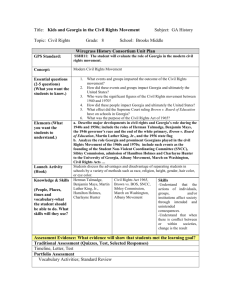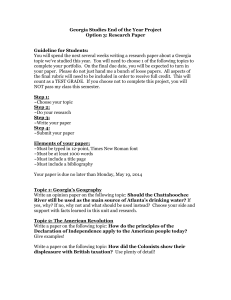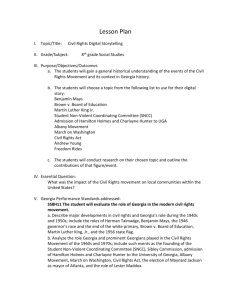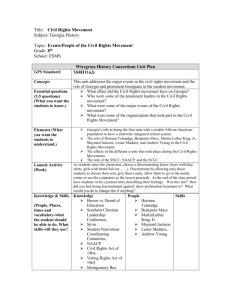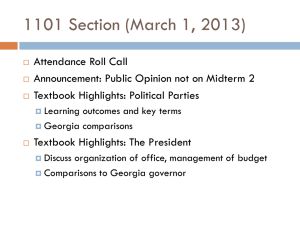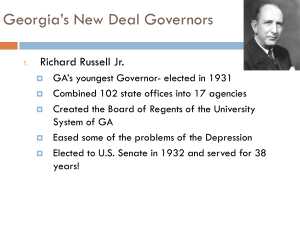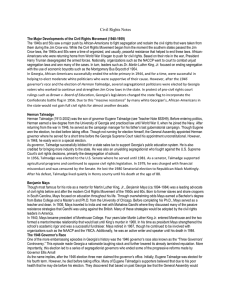History Standard
advertisement
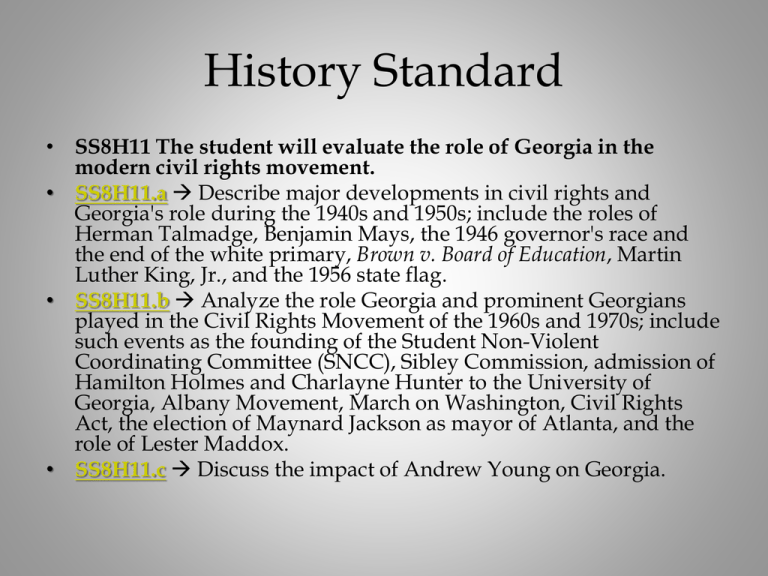
History Standard • SS8H11 The student will evaluate the role of Georgia in the modern civil rights movement. • SS8H11.a Describe major developments in civil rights and Georgia's role during the 1940s and 1950s; include the roles of Herman Talmadge, Benjamin Mays, the 1946 governor's race and the end of the white primary, Brown v. Board of Education, Martin Luther King, Jr., and the 1956 state flag. • SS8H11.b Analyze the role Georgia and prominent Georgians played in the Civil Rights Movement of the 1960s and 1970s; include such events as the founding of the Student Non-Violent Coordinating Committee (SNCC), Sibley Commission, admission of Hamilton Holmes and Charlayne Hunter to the University of Georgia, Albany Movement, March on Washington, Civil Rights Act, the election of Maynard Jackson as mayor of Atlanta, and the role of Lester Maddox. • SS8H11.c Discuss the impact of Andrew Young on Georgia. Herman Talmadge & 1956 GA Flag Herman Talmadge Georgia Flag Flap… • Received write-in votes in the 1946 Governor’s election • The flag on the left was in place before the Brown v. Board of Education decision made segregation illegal. • In response to the Brown decision, the General Assembly changed the flag to include the Confederate “X” • The flag was changed in 2001 and lastly in 2004 • Part of 3 Governor’s Controversy – Elected Governor in a special election in 1948 • Began sales tax to support education • Brought more industry to the state • Supporter of Segregation • Elected to US Senate in 1956 – Charged with financial misconduct in 1979 & lost reelection Benjamin Mays & MLK • Dr. Mays was born to former slaves and sharecroppers in SC • Traveled to India in 1936 and met with Ghandi • Became President of Morehouse College in 1940 – Served as a professor and a mentor to MLK • Martin Luther King, Jr. – 1929 – 1968 • Minister in Montgomery when Rosa Parks was arrested – This led to his involvement and eventual leadership in the civil rights movement • Supporter of NONVIOLENCE – Inspired by Ghandi & Mays • Received Nobel Peace Prize • Was assassinated in Memphis. Tennessee in 1968 Civil Rights Events/Groups • SNCC – Student Non-violent Coordinating Committee • Sit-ins & protests • SCLC – Southern Christian Leadership Conference • Albany Movement – Not a success – tried to do too much • March on Washington – Aug. 1963 over 200,000 attended; “I have a dream” Sibley Commission & UGA • In 1960, the Sibley Commission was tasked with studying the issue of integration of public schools – 60% of Georgians preferred closing schools vs. integrating • In 1961, UGA admitted its first two black students – Charlayne Hunter & Hamilton Holmes • Atlanta public schools integrated in 1961 but it took almost 10 years for every school in Georgia to finally follow… Governor Lester Maddox • 1966 – 1971 • The last overtly segregationist governor in Georgia history – Appointed more African Americans to government positions than all other governors before him combined • Hosted “People’s Days” twice a month to allow citizens to voice complaints or receive assistance – Gained support of both white & black voters – Refused to fly flags at half staff after the murder of Dr. King Jackson & Young Maynard Jackson • Graduated from Morehouse at 18 • Elected Mayor of Atlanta at age 35 (1973 – 1981; 1990-1994) – 1ST BLACK MAYOR OF A MAJOR SOUTHERN CITY • Important because of Atlanta’s role in the Confederacy • Expanded the airport, MARTA, and increased the number of black police officers • Helped bring the 1996 Olympics to Georgia • Died in 2003 Andrew Young • Came to GA as a minister • Began working with the SCLC to assist with voter registration – Became a close associate and friend of Dr. King • With MLK on the day of his assassination • 1972 – became Georgia’s first Black US Congressman since Reconstruction • 1977 – appointed US Ambassador to the United Nations by Pres. Carter • 1981 – elected Mayor of Atlanta • Helped to bring the 1996 Olympics to Georgia • Continues to work world-wide for equality still today
